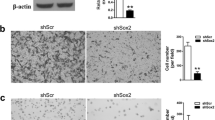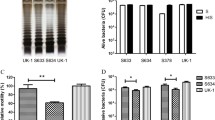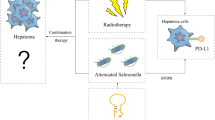Abstract
Hepatocellular carcinoma (HCC) is one of the most aggressive carcinomas. Limited therapeutic options, mainly due to a fragmented genetic understanding of HCC, and major HCC resistance to conventional chemotherapy are the key reasons for a poor prognosis. Thus, new effective treatments are urgent and gene therapy may be a novel option. Signal transducer and activator of transcription 3 (Stat3) is a highly studied member of the STAT family. Inhibition of Stat3 signaling has been found to suppress tumor growth and improve survival, providing a molecular target for cancer therapy. Furthermore, HCC is a hypervascular tumor and angiogenesis plays a crucial role in tumor growth and metastasis. Thus, anti-angiogenic therapy, combined with inhibition of Stat3, may be an effective approach to combat HCC. We tested the effect that the combination therapy consisting of endostatin (a powerful angiogenesis inhibitor) and Stat3-specific small interfering RNA, using a DNA vector delivered by attenuated S. typhimurium, on an orthotopic HCC model in C57BL/6 mice. Although antitumor effects were observed with either single therapeutic treatment, the combination therapy provided superior antitumor effects. Correlated with this finding, the combination treatment resulted in significant alteration of Stat3 and endostatin levels and that of the downstream gene VEGF, decreased cell proliferation, induced cell apoptosis and inhibited angiogenesis. Importantly, combined treatment also elicited immune system regulation of various immune cells and cytokines. This study has provided a novel cancer gene therapeutic approach.





Similar content being viewed by others
References
El-Serag HB, Rudolph KL (2007) Hepatocellular carcinoma: epidemiology and molecular carcinogenesis. Gastroenterology 132(7):2557–2576. doi:10.1053/j.gastro.2007.04.061
Lau WY, Lai EC (2009) The current role of radiofrequency ablation in the management of hepatocellular carcinoma: a systematic review. Ann Surg 249(1):20–25. doi:10.1097/SLA.0b013e31818eec29
Jemal A, Bray F, Center MM, Ferlay J, Ward E, Forman D (2011) Global cancer statistics. CA Cancer J Clin 61(2):69–90. doi:10.3322/caac.20107
Sotiropoulos GC, Molmenti EP, Losch C, Beckebaum S, Broelsch CE, Lang H (2007) Meta-analysis of tumor recurrence after liver transplantation for hepatocellular carcinoma based on 1,198 cases. Eur J Med Res 12(10):527–534
Song TJ, Ip EW, Fong Y (2004) Hepatocellular carcinoma: current surgical management. Gastroenterology 127(5 Suppl 1):S248–S260
Tang ZY, Ye SL, Liu YK, Qin LX, Sun HC, Ye QH, Wang L, Zhou J, Qiu SJ, Li Y, Ji XN, Liu H, Xia JL, Wu ZQ, Fan J, Ma ZC, Zhou XD, Lin ZY, Liu KD (2004) A decade’s studies on metastasis of hepatocellular carcinoma. J Cancer Res Clin Oncol 130(4):187–196. doi:10.1007/s00432-003-0511-1
Cross D, Burmester JK (2006) Gene therapy for cancer treatment: past, present and future. Clin Med Res 4(3):218–227
Bowman T, Garcia R, Turkson J, Jove R (2000) STATs in oncogenesis. Oncogene 19(21):2474–2488. doi:10.1038/sj.onc.1203527
Yu H, Jove R (2004) The STATs of cancer—new molecular targets come of age. Nat Rev Cancer 4(2):97–105. doi:10.1038/nrc1275
Wang T, Niu G, Kortylewski M, Burdelya L, Shain K, Zhang S, Bhattacharya R, Gabrilovich D, Heller R, Coppola D, Dalton W, Jove R, Pardoll D, Yu H (2004) Regulation of the innate and adaptive immune responses by Stat-3 signaling in tumor cells. Nat Med 10(1):48–54. doi:10.1038/nm976
Buettner R, Mora LB, Jove R (2002) Activated STAT signaling in human tumors provides novel molecular targets for therapeutic intervention. Clin Cancer Res 8(4):945–954
Zhang L, Gao L, Li Y, Lin G, Shao Y, Ji K, Yu H, Hu J, Kalvakolanu DV, Kopecko DJ, Zhao X, Xu DQ (2008) Effects of plasmid-based Stat3-specific short hairpin RNA and GRIM-19 on PC-3 M tumor cell growth. Clin Cancer Res 14(2):559–568. doi:10.1158/1078-0432.CCR-07-1176
Zhang L, Gao L, Zhao L, Guo B, Ji K, Tian Y, Wang J, Yu H, Hu J, Kalvakolanu DV, Kopecko DJ, Zhao X, Xu DQ (2007) Intratumoral delivery and suppression of prostate tumor growth by attenuated Salmonella enterica serovar typhimurium carrying plasmid-based small interfering RNAs. Cancer Res 67(12):5859–5864. doi:10.1158/0008-5472.CAN-07-0098
Kim HJ, Kim SM, Park KR, Jang HJ, Na YS, Ahn KS, Kim SH (2011) Decursin chemosensitizes human multiple myeloma cells through inhibition of STAT3 signaling pathway. Cancer Lett 301(1):29–37. doi:10.1016/j.canlet.2010.11.002
Ueda K, Terada T, Nakanuma Y, Matsui O (1992) Vascular supply in adenomatous hyperplasia of the liver and hepatocellular carcinoma: a morphometric study. Hum Pathol 23(6):619–626
O’Reilly MS, Boehm T, Shing Y, Fukai N, Vasios G, Lane WS, Flynn E, Birkhead JR, Olsen BR, Folkman J (1997) Endostatin: an endogenous inhibitor of angiogenesis and tumor growth. Cell 88(2):277–285
Ding I, Sun JZ, Fenton B, Liu WM, Kimsely P, Okunieff P, Min W (2001) Intratumoral administration of endostatin plasmid inhibits vascular growth and perfusion in MCa-4 murine mammary carcinomas. Cancer Res 61(2):526–531
Peroulis I, Jonas N, Saleh M (2002) Antiangiogenic activity of endostatin inhibits C6 glioma growth. Int J Cancer 97(6):839–845. doi:10.1002/ijc.10115
Li XP, Li CY, Li X, Ding Y, Chan LL, Yang PH, Li G, Liu X, Lin JS, Wang J, He M, Kung HF, Lin MC, Peng Y (2006) Inhibition of human nasopharyngeal carcinoma growth and metastasis in mice by adenovirus-associated virus-mediated expression of human endostatin. Mol Cancer Ther 5(5):1290–1298. doi:10.1158/1535-7163.MCT-05-0348
Berger AC, Feldman AL, Gnant MF, Kruger EA, Sim BK, Hewitt S, Figg WD, Alexander HR, Libutti SK (2000) The angiogenesis inhibitor, endostatin, does not affect murine cutaneous wound healing. J Surg Res 91(1):26–31. doi:10.1006/jsre.2000.5890
Sorensen DR, Read TA, Porwol T, Olsen BR, Timpl R, Sasaki T, Iversen PO, Benestad HB, Sim BK, Bjerkvig R (2002) Endostatin reduces vascularization, blood flow, and growth in a rat gliosarcoma. Neuro Oncol 4(1):1–8
Boehm T, Folkman J, Browder T, O’Reilly MS (1997) Antiangiogenic therapy of experimental cancer does not induce acquired drug resistance. Nature 390(6658):404–407. doi:10.1038/37126
Pawelek JM, Low KB, Bermudes D (1997) Tumor-targeted Salmonella as a novel anticancer vector. Cancer Res 57(20):4537–4544
Low KB, Ittensohn M, Le T, Platt J, Sodi S, Amoss M, Ash O, Carmichael E, Chakraborty A, Fischer J, Lin SL, Luo X, Miller SI, Zheng L, King I, Pawelek JM, Bermudes D (1999) Lipid A mutant Salmonella with suppressed virulence and TNFalpha induction retain tumor-targeting in vivo. Nat Biotechnol 17(1):37–41. doi:10.1038/5205
Sorenson BS, Banton KL, Frykman NL, Leonard AS, Saltzman DA (2008) Attenuated Salmonella typhimurium with interleukin 2 gene prevents the establishment of pulmonary metastases in a model of osteosarcoma. J Pediatr Surg 43(6):1153–1158. doi:10.1016/j.jpedsurg.2008.02.048
Yuhua L, Kunyuan G, Hui C, Yongmei X, Chaoyang S, Xun T, Daming R (2001) Oral cytokine gene therapy against murine tumor using attenuated Salmonella typhimurium. Int J Cancer 94(3):438–443. doi:10.1002/ijc.1489
Jiang Z, Zhao P, Zhou Z, Liu J, Qin L, Wang H (2007) Using attenuated Salmonella typhi as tumor targeting vector for MDR1 siRNA delivery. Cancer Biol Ther 6(4):555–560
Hohmann EL, Oletta CA, Killeen KP, Miller SI (1996) phoP/phoQ-deleted Salmonella typhi (Ty800) is a safe and immunogenic single-dose typhoid fever vaccine in volunteers. J Infect Dis 173(6):1408–1414
Gao L, Zhang L, Hu J, Li F, Shao Y, Zhao D, Kalvakolanu DV, Kopecko DJ, Zhao X, Xu DQ (2005) Down-regulation of signal transducer and activator of transcription 3 expression using vector-based small interfering RNAs suppresses growth of human prostate tumor in vivo. Clin Cancer Res 11(17):6333–6341. doi:10.1158/1078-0432.CCR-05-0148
Weidner N, Semple JP, Welch WR, Folkman J (1991) Tumor angiogenesis and metastasis—correlation in invasive breast carcinoma. N Engl J Med 324(1):1–8. doi:10.1056/NEJM199101033240101
Abdollahi A, Hahnfeldt P, Maercker C, Grone HJ, Debus J, Ansorge W, Folkman J, Hlatky L, Huber PE (2004) Endostatin’s antiangiogenic signaling network. Mol Cell 13(5):649–663
Wang RF (2006) Immune suppression by tumor-specific CD4+ regulatory T-cells in cancer. Semin Cancer Biol 16(1):73–79. doi:10.1016/j.semcancer.2005.07.009
Griffiths RW, Elkord E, Gilham DE, Ramani V, Clarke N, Stern PL, Hawkins RE (2007) Frequency of regulatory T cells in renal cell carcinoma patients and investigation of correlation with survival. Cancer Immunol Immunother 56(11):1743–1753. doi:10.1007/s00262-007-0318-z
Visser J, Nijman HW, Hoogenboom BN, Jager P, van Baarle D, Schuuring E, Abdulahad W, Miedema F, van der Zee AG, Daemen T (2007) Frequencies and role of regulatory T cells in patients with (pre)malignant cervical neoplasia. Clin Exp Immunol 150(2):199–209. doi:10.1111/j.1365-2249.2007.03468.x
Schaefer C, Kim GG, Albers A, Hoermann K, Myers EN, Whiteside TL (2005) Characteristics of CD4+ CD25+ regulatory T cells in the peripheral circulation of patients with head and neck cancer. Br J Cancer 92(5):913–920. doi:10.1038/sj.bjc.6602407
Takata Y, Nakamoto Y, Nakada A, Terashima T, Arihara F, Kitahara M, Kakinoki K, Arai K, Yamashita T, Sakai Y, Mizukoshi E, Kaneko S (2011) Frequency of CD45RO+ subset in CD4+ CD25(high) regulatory T cells associated with progression of hepatocellular carcinoma. Cancer Lett 307(2):165–173. doi:10.1016/j.canlet.2011.03.029
Nelson D, Ganss R (2006) Tumor growth or regression: powered by inflammation. J Leukoc Biol 80(4):685–690. doi:10.1189/jlb.1105646
Marie JC, Letterio JJ, Gavin M, Rudensky AY (2005) TGF-beta1 maintains suppressor function and Foxp3 expression in CD4+ CD25+ regulatory T cells. J Exp Med 201(7):1061–1067. doi:10.1084/jem.20042276
Hershberg RM, Mayer LF (2000) Antigen processing and presentation by intestinal epithelial cells—polarity and complexity. Immunol Today 21(3):123–128
Acknowledgments
This study was supported by grands from the National Natural Science Foundation of China (No. 30801354 and No. 30970791), Specialized Research Fund for the Doctoral Program of Higher Education of China (No.200801831077) and Jilin Provincial Science & Technology Department (No. 20080154). We thank Professor Liying Wang and Professor Yongli Bao for helpful suggestions.
Conflict of interest
The authors declare that they have no conflict of interest.
Author information
Authors and Affiliations
Corresponding authors
Additional information
Huijie Jia and Yang Li authors contributed equally to this work.
Electronic supplementary material
Below is the link to the electronic supplementary material.
Rights and permissions
About this article
Cite this article
Jia, H., Li, Y., Zhao, T. et al. Antitumor effects of Stat3-siRNA and endostatin combined therapies, delivered by attenuated Salmonella, on orthotopically implanted hepatocarcinoma. Cancer Immunol Immunother 61, 1977–1987 (2012). https://doi.org/10.1007/s00262-012-1256-y
Received:
Accepted:
Published:
Issue Date:
DOI: https://doi.org/10.1007/s00262-012-1256-y




